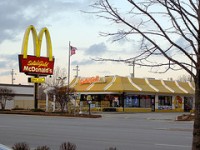
Every small business owner needs to look at the business reports daily, weekly and monthly on a regular basis to stay up-to-date with how their business is performing. You need to understand what key performance metrics to look at in those reports. We showed how to identify and track key performance indicators in this post.
You don’t have to start from zero when looking for key performance metrics for your business. Many types of small businesses have “standard” set of metrics. As a small business and franchise owner you should be aware of these metrics. In this post we will summarize the key metrics for retail businesses and fast food / restaurants.
Retail
Retail covers wide spectrum of businesses such as clothing stores, cell phone outlets, hardware stores, sporting goods, etc. – in short any small business that buys physical goods from manufacturer or wholesaler and sells at a markup to consumers.
The key metrics for retail business are as follows:
- Sales increase – How much sales increase for the same store from one month to next and year over year. In retail businesses this is also known as sales comp (comparison of sales)
- Gross Margin – Total revenue minus purchase cost (COGs or amount paid to purchase the merchandise). The gross margin shows how much price premium you are able to get from customers as well as how cheaply you can buy your goods.
- Inventory turnover – Shows how fast you are selling the goods. It is calculated as total sales for the year divided by average inventory. For example, if your total annual sales is $500,000 and average inventory is $100,000; the inventory turnover will be 5; which means you are “turning over” your inventory five times a year. Higher inventory turnover is desired for retail business.
- Repeat Customers – High repeat customer count shows that your customers like what you are selling and they keep coming back to your business for more. You can show this metrics either as % of total sales from repeat customers or % of total customers that are repeat.
Fast food / Restaurant
There are number of small businesses that fall in this category. They include fast food stores, coffee shops, ice cream parlors, pizza stores and so on. This is one of the largest categories of small businesses in the U.S.
The key metrics for fast food / restaurant business are as follows:
- Food Cost – Calculated as % of total expense is food cost. Depending on the type of restaurant and franchise it can run anywhere from 25% to 35%. For larger franchise chains such as Subway and McDonald’s the food cost is usually lower due to their large buying power.
- Labor Cost – This is one of the largest expense item for restaurants other than food cost. Similar to food cost the labor cost can range from 25% to 35% of total expense.
- Weekly Sales – This is one of the standard sales related numbers that everyone looks at. As you might expect, it can vary widely from one franchise to next – ranging anywhere from few thousand to tens of thousands. The key number to look at is change from week to week and compared to prior year.
- Average Order per Customer – As you would expect, higher average order per customer is better restaurants. It means that the customers are ordering more items from your menu.
- Employee Turnover – The staff turnover is one of the biggest issues in restaurant business. It is not unusual to find annual turnover in access of 50% for the restaurants. Of course, lower turnover is good for your business. We showed how to reduce the employee turnover in previous post
We will cover additional types of small businesses in the next post. In the meantime, let us know what metrics you look at for your small business.






